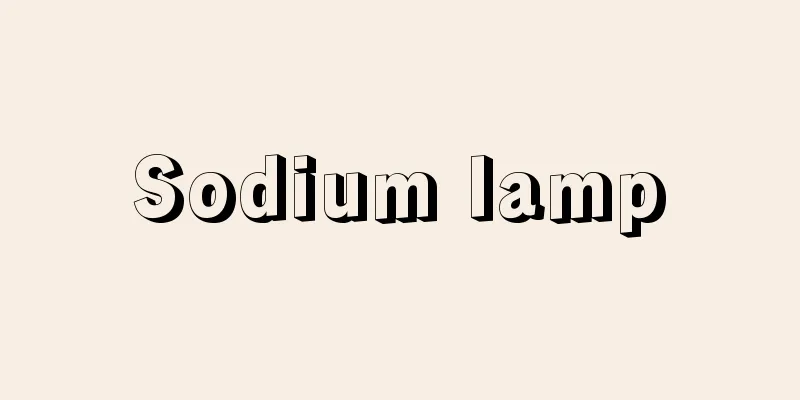Sodium lamp

|
A lamp that uses light emitted by an arc discharge in sodium vapor. It is broadly divided into low-pressure sodium lamps and high-pressure sodium lamps. (1) Low-pressure sodium lamps: These lamps have a sodium vapor pressure of about 0.5 pascals. They are orange-yellow lamps that most efficiently emit sodium D lines (589.0 and 589.6 nanometers). A practical lamp was completed in 1932 by Gilles Holst (1886-1968) of the Netherlands. They were put to practical use in Japan in 1934 (Showa 9), but did not become widespread until 1957 (Showa 32). The lamp is constructed with a light-emitting tube made of special glass that is not affected by sodium vapor, bent into a U-shape, and filled with sodium metal and a mixture of neon and a small amount of argon as a starting gas. The outer tube is kept at a high vacuum to reduce heat loss, and the inner surface of the outer tube is coated with a transparent indium oxide film that reflects infrared rays, which returns the generated infrared rays to keep the light tube warm. The temperature of the light-emitting tube wall is set to about 260°C to maintain the most efficient sodium vapor pressure. A ballast is required to light the lamp. It is the most efficient of all practical light sources (175 lumens/watt), but because it emits monochromatic orange-yellow light, its color rendering is very poor, so it is only used for lighting tunnels and the like. (2) High-pressure sodium lamps: Lamps that use the light of a discharge when the sodium vapor pressure is about 1.3 x 10 4 in pascals. They emit yellowish-white light and are the most efficient of all practical white light sources (115-140 lumens/watt at 400 watts). In 1963, a translucent alumina ceramic arc tube that can withstand high-temperature sodium vapor was developed in the United States, and it was put to practical use by increasing the sodium vapor pressure. In Japan, it was completed in 1969. The lamp structure is a translucent alumina ceramic arc tube with electrodes sealed at both ends with ceramic caps or niobium metal caps to form an arc tube, which is filled with sodium, mercury, and xenon gas (or argon and neon gas, etc.) for starting. The inside of the outer glass bulb is kept at a high vacuum. The light color of high-pressure sodium lamps is a warm yellowish-white color (color temperature 2100 Kelvin), and the color rendering is slightly better than that of low-pressure sodium lamps, and color differentiation is sufficient. Because of its high efficiency, it has come to be widely used for general outdoor lighting such as for roads, high-ceiling factory lighting, and sports lighting. In addition, high-color-rendering high-pressure sodium lamps, which have an even higher sodium vapor content and significantly improved color rendering, have also come into use. These lamps produce a light color similar to that of incandescent bulbs and are used for store lighting. [Akio Obara and Makoto Bessho] [Reference] | | | |©Shogakukan "> Sodium lamp structure ©Shogakukan "> Spectral distribution of sodium lamp Source: Shogakukan Encyclopedia Nipponica About Encyclopedia Nipponica Information | Legend |
|
ナトリウム蒸気中のアーク放電によって放射される光を利用したランプ。低圧ナトリウムランプと高圧ナトリウムランプとに大別される。 (1)低圧ナトリウムランプ ナトリウムの蒸気圧を約0.5パスカルとしたもの。もっとも効率よくナトリウムのD線(589.0と589.6ナノメートル)を発光する橙黄(とうこう)色のランプである。1932年オランダのホルストGilles Holst(1886―1968)によって実用的なランプが完成。日本では1934年(昭和9)に実用化されたが、普及したのは1957年(昭和32)からである。 ランプの構造は、ナトリウム蒸気に侵されない特殊ガラスを発光管とし、これをU字形に曲げ、ナトリウム金属と始動補助用ガスとしてネオンと少量のアルゴンの混合ガスを封入する。外管は熱損失を少なくするため高真空に保たれ、また外管内面に透光性でしかも赤外線を反射する酸化インジウム膜を施し、発生した赤外線を元へ戻して発光管の保温に利用する。発光管の管壁温度は、もっとも効率のよいナトリウム蒸気圧を保つため約260℃とする。ランプの点灯には安定器が必要である。効率は実用光源のなかでもっとも高い(175ルーメン/ワット)が、橙黄色の単色光なので、演色性が非常に悪いため、トンネルなどの照明に使用されるにすぎない。 (2)高圧ナトリウムランプ ナトリウムの蒸気圧がパスカル単位で約1.3×104における放電の光を利用したランプ。黄白色の光で、実用白色光源のなかでもっとも効率が高い(400ワットで115~140ルーメン/ワット)。1963年アメリカで高温のナトリウム蒸気に耐える透光性アルミナセラミックス発光管が開発され、ナトリウムの蒸気圧をあげることにより実用化された。日本では1969年に完成している。ランプの構造は、透光性アルミナセラミックス発光管の両端に電極をセラミックキャップまたはニオブ金属キャップで封止して発光管とし、これにナトリウムのほか水銀、始動用のキセノンガス(またはアルゴンとネオンガスなど)が封入されている。外管ガラス球内は高真空に保たれている。高圧ナトリウムランプの光色は暖かみのある黄白色(色温度2100ケルビン)で、演色性は低圧ナトリウムランプよりややよくなり、色別は十分できる。効率が高いので、道路などの屋外一般照明や高天井の工場照明、スポーツ照明に多く使用されるようになった。 なお、ナトリウム蒸気をさらに高くして、演色性を大幅に改善した高演色高圧ナトリウムランプも使われるようになったが、これは電球の光色にも似ており店舗照明に用いられている。 [小原章男・別所 誠] [参照項目] | | | |©Shogakukan"> ナトリウムランプの構造 ©Shogakukan"> ナトリウムランプの分光分布 出典 小学館 日本大百科全書(ニッポニカ)日本大百科全書(ニッポニカ)について 情報 | 凡例 |
Recommend
Earl of Leicester
A favorite of Elizabeth I of England. Fifth son of...
Pylorus
…the stomach is a sac-like part of the digestive ...
Fountain pen - mannenhitsu (English spelling) fountain pen
A type of writing instrument that uses capillary ...
Disclosure - Disclosure (English spelling)
This refers to a company, government, local gover...
Child welfare facility - JIDOU FUKUSHISHISSETSU
A type of social welfare facility that is intende...
Electrostatic induction
It is also called electrostatic induction. When a...
American wigeon
...It has a clear, whistling voice, with each not...
joinery
... Generally, carpenters are in charge of the st...
Prunus spachiana (English spelling) Prunusspachiana
…[Hiroshi Aramata]. … *Some of the terminology th...
small cranberry
... Section V. oxycoccus is widely distributed in...
Kokugakuin University
It is a private institution. Its origins lie in K...
Osmanthus fortunei (English spelling) Osmanthusfortunei
… [Toshio Hamatani]. … *Some of the terminology t...
《Ayad Girl I Zareeran》 - Ayad Girl I Zareeran
…The names of Bārbad and others are known as mins...
Curriculum - Curriculum
〘noun〙 The former name of the educational curricul...
Carlo Cafiero
1846‐92 Italian socialist. Influenced by the Paris...









